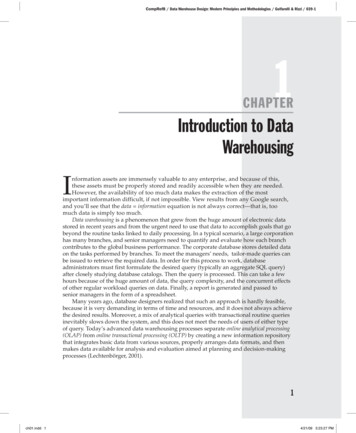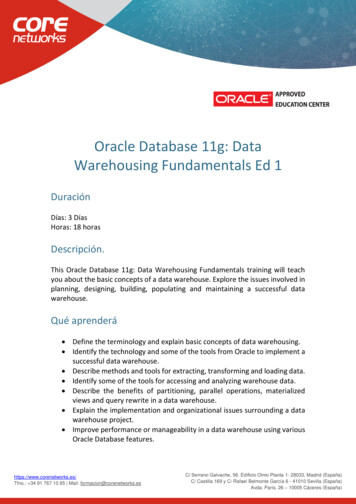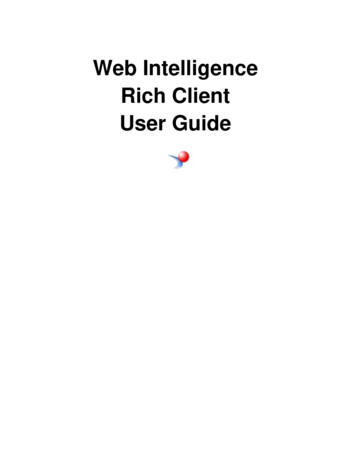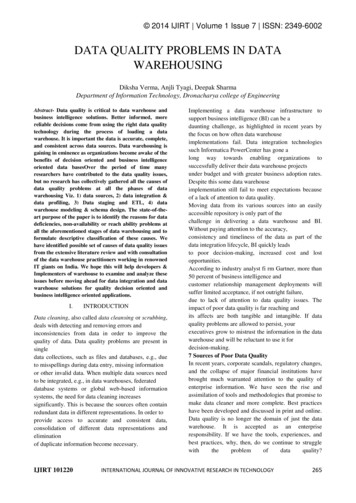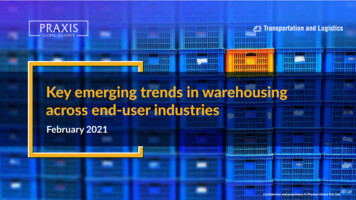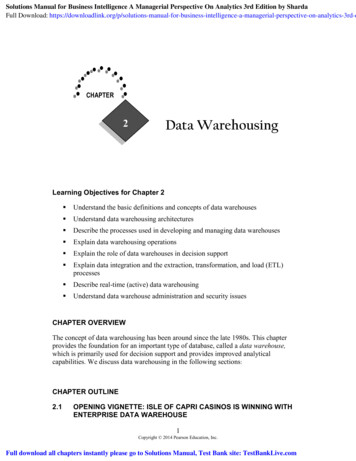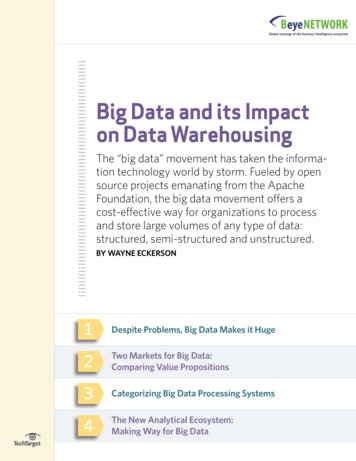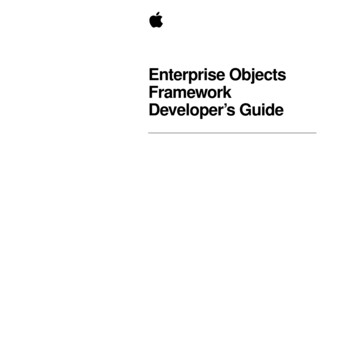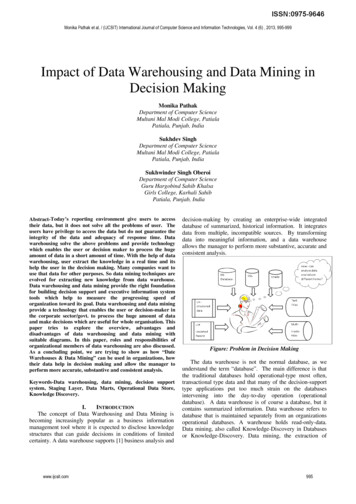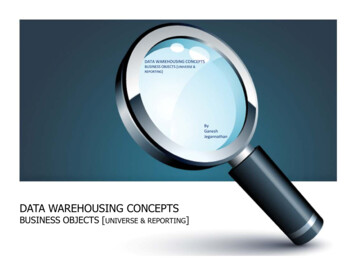
Transcription
DATA WAREHOUSING CONCEPTSBUSINESS OBJECTS [UNIVERSE &REPORTING]ByGaneshJegannathanDATA WAREHOUSING CONCEPTSBUSINESS OBJECTS [UNIVERSE & REPORTING]
Data Warehousing ConceptsBY Ganesh Jegannathan, MphasiS an HP Company
Before we BeginNeed to understand DataDatabaseDBMS RDBMS / NDBMS / HDBMSRDBMSRDBMS – RelationshipsData ModelData:Data can be defined as, any information which helps to run your business. In an HRapplication data is the employee, his salary information, employee name. In RDBMS, DATA is stored in the form of rows and tablesBY Ganesh Jegannathan, MphasiS an HP Company
Database:Software which is used to maintain all the data an organization has. We can have multiple tableswhich contains many rows. Databases organize the data in such a way it is very easy tomaintain.RDBMS:RDBMS stands for Relational Database Management system; it works based on the set theory,entities and its relationship. An entity is a real world thing, when you define a business, youdeal with customer, products, sales etc, these are called entities. All the entities have its ownproperties which we call as attributes / columns in the database. In employee entity (Table) westore all the information about employees (Name, Address, salary, manager, etc).RDBMS – RelationshipsOne to One One to Many / Many to One Many to Many Person and PAN CardPerson and Credit CardPerson and DoctorBY Ganesh Jegannathan, MphasiS an HP Company
Data ModelIt’s a pictorial representation of the entities, relationships between entities and the attributeswhich reflects how the data is stored to run the business. In software development life cycle,after the requirement gathering phase, designing the data model is done. As a part of theproject, we develop conceptual model, logical model and physical model.Conceptual Model:It is a very high level view (bird’s view) of how the business runs. We cross verify the modelwith the business to make sure we are on the right track. In this phase, we identify most ofthe entities which are required by business. You will see lot of many to many relationshipsbetween the identified entities.EMPDeptBY Ganesh Jegannathan, MphasiS an HP Company
Logical Model:In this model we actually complete the model with all the details of entities including theattributes, domains and its relationships. We resolve all the many to many relationships usingassociative tables in this phase. You can completely visualize the data movement with in thebusiness using this model. Every project must have a logical model even if the project is verysmall.EMPEmp noNameD noDEPTD nonmPhysical Model:We create the tables in their respective databases. Here DBA will take a call on identifyingcertain changes to logical model to show better performance while running the application.These DBA s will be good in the respective databases and its utilities so that they can take a callon how best they can deploy the data model. At the logical level we call entities and attributeswhere as at physical level we call it as tables and columns.Physically creating tables and joinsBY Ganesh Jegannathan, MphasiS an HP Company
Normalization VS De-NormalizationDe-Normalized formEmp noEnameD Name1TIMSales2JOHNSalesNormalized formDept noD Name100SalesEmp noEnameDept nt data resulting in using lessstorage space which in turn makes ourtransaction to run faster . .This way we could have speed up thetransaction we do. So, by splitting thetables to smaller, the inserts, updatesand deletes run faster where as selectstatements run slower as we join manytables (this is the disadvantage).De-Normalization: Only to speed up the QueryBY Ganesh Jegannathan, MphasiS an HP Company
NormalizationIts about breaking entities into their most granular form– 1st Normal Form (1NF) Every attribute must be atomic Repeating attributes moved to a separate entity– 2nd Normal form (2NF) No attributes in the child entity are really facts about the parent Its usually applies to dependant entities All the attributes should be functionally / partially dependent on theprimary key– 3rd Normal form (3NF) All the attributes should be primarily dependent on the primarykey If attributes and key of another entity appear as attributes of anentity, move them back to other entity or to a new entity (oftena type entity)BY Ganesh Jegannathan, MphasiS an HP Company
ExampleProgramWorkerRoleThis is OK if .Any combination isvalidAssignmentBUT .Workers have defined rolePrograms require certain rolesWorkers are assigned programs independent of rolesThen we will end up writing lots and lots of coding to make sure toimplement these business rules. If we normalize it some of the rules areautomatically taken care ofBY Ganesh Jegannathan, MphasiS an HP Company
Data WarehousingData Warehousing ?Problem StatementProblemStatementInordertounderstan atawarehouse,whataretheadvantageswe will take an example to explain the same.Wewilltakecustomers asacompanywhichan ��start edwith10employeeswithaturnaroundofsay500K pentandhowthefundsareutilizedinthefinger tips.Atthisstage they haveonly two applications whichkeeps trackof supplier and customer 00items)fromdifferentsuppliers(150).Astheb usinessgrow,thenumb ployeestrengthof3000andtheturnoverisover750million .Atthis stageusuallyitsvery dif toanswersomeoftheb usinessquestionsandtheturnaroundti skillstomakethishappenandasthenumb erofadhoc requirementsb yssometimesevenmorewhichisb asedonthecomplexity of the requirement.Not a 0 degree of the corporate view.Intheabove scenario,say wehaveordermanagementwherewedealwithordersplacedby customers, rejections, canceling orders, we have SMG related activist such as ees,movementofthemtodifferentgrades, salary information llyrejectstheorderstheyplacedb ableamount.Want to compare which customer grades palces the ca ncelled orders.It’s a PROCESSDataWarehouse isNOT a specifictechnologyRalphKimbalNOT possible topurchase DataWarehouse, butit is possible tobuild oneBillInmonBY Ganesh Jegannathan, MphasiS an HP Company
InformationData WarehouseA single, complete and consistent store of data obtained froma variety of different sources made available to end users inwhat they can understand and use in a business context.Data[Barry Devlin]Subject Oriented, Integrated, Time varying, Non Volatilecollection of data that is used primarily in organizationaldecision making[Bill Inmon]A process of transforming data into information & makingavailable to users in timely enough manner to make difference[Forrester Research, April 1996]BY Ganesh Jegannathan, MphasiS an HP Company
Subject Oriented– Data is arranged by the common subject area of a company, such assales, marketing, finance.Integrated– Data warehouse integrates data derived from various functionalsystems in the organizations and provides a unified and consistentview of the overall organizational situationTime Variant– Warehouse data represent the flow of data through time, and queriesare based on time range.Non-Volatile– Data are always added to the warehouse for maintaining thecompany’s entire history.BY Ganesh Jegannathan, MphasiS an HP Company
Why Data Warehousing?Need of Intelligent Information in Competitive MarketWho are the potentialCustomers ?Which Products are soldthe most ?What will be the impacton revenue ?Results of promotionschemes introduced ?What are the regionwise preferences ?What are the competitorproducts ?What are the projectedsales ?What if you sale morequantity of a particularproduct ?BY Ganesh Jegannathan, MphasiS an HP Company
OLTP vs. Data ��––Application OrientedUsed to run businessDetailed dataCurrent up to dateIsolated DataRepetitive accessClerical UserPerformance SensitiveFew Records accessed at a time(tens)Read/Update AccessNo data redundancy , De-NormalizedDatabase Size 100MB -100 GBTransaction throughput is theperformance metricThousands of usersManaged in entiretyWAREHOUSE Subject OrientedUsed to analyze businessSummarized and refinedSnapshot dataIntegrated DataAd-hoc accessKnowledge User (Manager)Performance relaxedLarge volumes accessed at atime(millions)Mostly Read (Batch Update)Redundancy present , NormalizedDatabase Size 100 GB - few terabytesQuery throughput is the performancemetricHundreds of usersManaged by subsetsBY Ganesh Jegannathan, MphasiS an HP Company
General DSS ArchitectureSOURCEOLTP 1ETLDWH / DBETL(Tool orTSQL)DataWarehouseDatabaseWeb clicksPre DefinedReportsAd hocReportingOLTP 2Market e the loop (write back to OLTP about the findings in DSSBY Ganesh Jegannathan, MphasiS an HP Company
Complete Warehouse Solution ArchitectureDataInformationData SourcesData ManagementMetadataLegacy DataThePosVISAtExternal Data mLoadOperational structuredBY Ganesh Jegannathan, MphasiS an HP Company
Example for a DSSOLTP 2OLTP 1ReportingDataWarehouseOLAPAnalyticsOLTP 3OLTP 4BY Ganesh Jegannathan, MphasiS an HP Company
To summarize .OLTP Systems areused to “run” a businessThe Data Warehouse helps to“optimize” the businessBY Ganesh Jegannathan, MphasiS an HP Company
Approaches to build Data WarehouseTop Down ApproachData WarehousetoData MartBottom Up ApproachData MarttoData WarehouseBY Ganesh Jegannathan, MphasiS an HP Company
Distributed Approach Various departments can start creating different data marts. Each can start workingindependently and see the ROI in a short span.In the long run integrating these data adds the complexity and Cost will be higher asthere are more systems to maintain.Gives only part of the answerRequires time and effort to put thepieces togetherNo guarantee it’s the right answerBY Ganesh Jegannathan, MphasiS an HP Company
Centralized Approach Centralized data warehouse contains the datain one place, easy to answer Any businessquestion. In the long run this has the costadvantage over the Non centralizeddata warehouse. Not very easy to implementas it needs more time and resources. ROIwon’t be seen until the implementation iscompleted. So recommended approach is toimplement the centralized data warehouseis, start with one subject area and keepadding one subject area at a time, this wayorganization will get the see the ROI atDeliversoneversionofvarious stagesthe truth for increased confidenceand speed in decision-makingBY Ganesh Jegannathan, MphasiS an HP Company
Data Marts From the Data Warehouse , atomic data flows to various departments for theircustomized needs. If this data is periodically extracted from data warehouse andloaded into a local database, it becomes a data mart. The data in Data Mart has a different level of granularity than that of DataWarehouse. Since the data in Data Marts is highly customized and lightly summarized , thedepartments can do whatever they want without worrying about resourceutilization. Also the departments can use the analytical software they find convenient. The cost of processing becomes very low.BY Ganesh Jegannathan, MphasiS an HP Company
Data Modeling VS Dimensional ntry-idNmDimensional Modeling is to ate-NmCountry-NmandData Modeling/ER Modeling is to livewith OLTP systemDimensions & FactsEntity & TransactionEntityCustomerFactBY Ganesh Jegannathan, MphasiS an HP Company
Data Warehousing SCHEMAS & OBJECTS A schema is a collection of database objects, including tables, views, indexes, andsynonyms. There is a variety of ways of arranging schema objects in the schema models designed fordata warehousing. The are: Star Schema Snowflake Schema Galaxy SchemaStar Schema: It Consists of a fact table connected to a set of dimensional tables Data is in Dimension tables is De-NormalizedSnowflake Schema: It is refinement of star schema where some dimensional hierarchy is normalized in to aset of dimensional tablesGalaxy Schema: Multiple fact tables share dimension tables viewed as acollection of stars, therefore called galaxy schemaBY Ganesh Jegannathan, MphasiS an HP Company
Dimensional ModelingStar SchemaVSComplete De-Normalized formSnow Flack SchemaNormalized Star SchemaSales Analysis ExampleActual sales goes into face and customerdetails, date, sales etc go to dimensionsNow you can visualize a snowflake does nothave redundant data in the dimension tablesThe visual of the model looks like star, so wecall it as star schema.We will lend up having lot of look up tablesfor the dimension tableIn case of start schema all the informationabout customer are stored in the same tableAs the no of tables become more the queryperformance goes downSo usually the dimensions in star schema arewider in nature meaning lot of columnsSo you have to take a decision on whether togo for star or snow flake depending on datavolume and the user performancerequirements etcSo your dimension will have lot of redundantinformation.BY Ganesh Jegannathan, MphasiS an HP Company
Star SchemaEmployee DimEmployeeKeyEmployee ID.Time DimTimeKeyThe Date.Shipper DimShipperKeyShipper D.Sales KeyRequired Data(Business Metrics)or (Measures).Branch DimBranchIDBranch no.Customer DimCustomerKeyCustomer ID.A star schema a highly De-Normalized, query-centric model whereinformation is broken into two groups: facts and dimensions.BY Ganesh Jegannathan, MphasiS an HP Company
Star Schema with Sample Data - ExampleBY Ganesh Jegannathan, MphasiS an HP Company
Snowflake SchemaStore DimensionDistrict IDRegion IDDistrict Desc.Region IDRegion Desc.Regional Mgr.STORE KEYStore DescriptionCityDistrict IDStateStore Fact TableSTORE KEYPRODUCT KEYPERIOD KEYDollarsUnitsPriceBY Ganesh Jegannathan, MphasiS an HP Company
Galaxy SchemaMultiple Groups of Facts links by few common sion3Fact2Dimension6Dimension5Fact3Dimension7BY Ganesh Jegannathan, MphasiS an HP Company
Data Warehousing ObjectsAll the three types of Schemas are described in the Data Modeling sectionVarious Objects used in Data Warehousing are:–––––Fact TablesDimension TablesHierarchiesUnique IdentifiersRelationshipsBY Ganesh Jegannathan, MphasiS an HP Company
Fact TypesAdditive facts: Additive facts are facts that can be summed up through all of thedimensions in the fact tableSemi-Additive facts: Semi-additive facts are facts that can be summed up for some of thedimensions in the fact tableNon-additive facts: Non-additive facts are facts that cannot be summed up for any of thedimensions Present in the fact tableBY Ganesh Jegannathan, MphasiS an HP Company
Types of Fact tables :Based on the classification there are two types of fact tables Cumulative SnapshotCumulativeThis type of fact table describes what has happened over a period of timeFor example this fact table may describe the total sales by product by store by dayThe facts for this type of fact tables are mostly additive. The first example is aCumulative fact table.SnapshotThis type of fact table describes the state of things in a particular instanceOf time, and usually includes more semi additive and non-additive facts.The second example presented is a snapshot fact tableBY Ganesh Jegannathan, MphasiS an HP Company
Data Warehousing Objects Contd .Dimension Tables: Dimension tables– Define business in terms already familiar to users– Wide rows with lots of descriptive text– Small tables (about a million rows)– Joined to fact table by a foreign key– heavily indexed– typical dimensionstime periods, geographic region (markets, cities),products, customers, salesperson, etc.BY Ganesh Jegannathan, MphasiS an HP Company
Dimension tables Types––––Slowly Changing dimensionsJunk DimensionsConfirmed DimensionsDegenerated DimensionsBY Ganesh Jegannathan, MphasiS an HP Company
Dimensions and SCDHistories are maintained over time periodThere are three different ways we capture the historySlowly Changing Dimension 1 (SCD1 / TYPE1)Slowly Changing Dimension 2 (SCD2 / TYPE2)Slowly Changing Dimension 3 (SCD3 / TYPE3)TYPE1 / SCD1:We use this type then we are not storing any history. Only the current information is stored inthis type of dimension. So if your business says, we don’t need history, then we can opt forTYPE1 / SCD1.OLTP TableSourceDW Dimension TableEmpno EnameJob1Mgr 20000 BlrTimSalLocTargetEmpno EnameJob1Mgr 20000 BlrTimSalLocBY Ganesh Jegannathan, MphasiS an HP Company
TYPE2 / SCD2:We use this method to store the complete history.We use a id called surrogate ID in TYPE II because the actual id canexists more than oncewe can do better analysis like while this was selling at ‘X’ we use to sell100 qty where as when are selling at ‘Y’ we are selling 150 qty etc. Ifwe don’t store the history you cannot get this kind of information fromDWSourceType 1 TargetEmpno Ename Job SalLoc1TimMgr 20000 alLocTimMgr20000 Blr1TimD-Mgr 20000 BlrEmpnoEnameJobSalLoc1TimD-Mgr 35000 Ny1TimD-Mgr35000NyBY Ganesh Jegannathan, MphasiS an HP Company
TYPE III /SCD3:In this method we store current and previous values of the dimension dataSourceEmpno EnameJob1Mgr 20000 BlrTimSalLocI st RunTargetEmpno EnameJobSalLocPre JobPre Sal Pre Loc1Mgr20000BlrNullNullTimNullOn Updating the source from Mgr to D-Mgr1TimD-Mgr20000BlrMgrNullNullBY Ganesh Jegannathan, MphasiS an HP Company
SCD 1-2-3 Pros and ConsAdvantages:This is the easiest way to handle the Slowly Changing dimension, Since there is no needto keep track of the old information.Disadvantages:All the history is lost. By applying this methodology, it is not possible to track back inhistory.Eg, In above case, company would not be able to know Christina lived in Illinois before.Advantages:This allows us to accurately keep all historical informationDisadvantages:This will cause the size of the table to grow fast where the number of rows for the tableis very high to start with, storage and performance can become a concernAdvantages:This does not increase the size of the table, since new information is updated. Thisallows us to keep some part of historyDisadvantages:Type 3 will not be able to keep all history where an attribute is changed more thanOnce. For eg, if Christina later moves from to Texas on December 15,2003 theCalifornia information is lostBY Ganesh Jegannathan, MphasiS an HP Company
Degenerated DimensionDegenerated dimension is a dimension which is derived from the fact table and doesn't have its owndimension table.Degenerate dimensions are often used when a fact table's grain represents transactional level dataand one wishes to maintain system specific identifiers such as order numbers, invoice numbers andthe like without forcing their inclusion in their own dimension.Confirmed DimensionsDimension which is fixed and reusable. It is also called as fixed dimension. It is a dimension whichdoesn't effect with respect to time.Ex : if name of the city is changed from Bombay to Mumbai, name will not change from time totime, once the change is done ,The change is permanent. This type of dimensions are calledconfirmed or fixed dimensions.Junk DimensionsA dimension where one can store random transactional codes, flags and textattributes that are not related to other dimensions and which provides a simple wayfor users to easily find those unrelated attributes. Ex: Martial Status : (Yes or No)Gender : (M or F) etcBY Ganesh Jegannathan, MphasiS an HP Company
OLAP Online Analytical Processing. The way analyst slice and dice the DW data.Viewing the fact information through multiple dimensions is called slice anddice. Example: if we see the revenue by product and year then we call thereport as multi dimensional reporting. In the industry we have three types ofOLAP.ROLAPMOLAPHOLAPUsually when we implement the DW, we create of static reports, some times wecall it as canned reports as well. As users become good in understanding the data,to analyze why such slip or peak happened in specific scenario we will open up forthe Ad hoc query. Using Adhoc query facility end users can pull in the data whatthey need in the way they want to see. Any tool, which exposes the DW modelthrough meta data and helps to create the report then we call it as BI tool.BY Ganesh Jegannathan, MphasiS an HP Company
What is OLAP? What is OLAP?– Online Analytical Processing. Viewing data in a multi dimensional way. Why OLAP?– “Slice and dice” for data warehouse.– RDBMS is a 2 dimensional way of storing / viewing the data– OLAP is a multi dimensional way of storing / viewing the dataBY Ganesh Jegannathan, MphasiS an HP Company
BUSINESS OBJECTS- Universe DesignerBY Ganesh Jegannathan, MphasiS an HP Company
OLAP What is OLAP?– Online Analytical Processing. Viewing data in a multi dimensional way. Why OLAP?– “Slice and dice” for data warehouse.– RDBMS is a 2 dimensional way of storing / viewing the data– OLAP is a multi dimensional way of storing / viewing the dataOLAP - TypesThree types of OLAP in the industry.1.2.3.MOLAP – Multi dimensional OLAP (Ex MSOLAP, Essbase, Cognos).ROLAP – Relational OLAP ( Ex Business Objects, Micro strategy).HOLAP – Hybrid OLAPBY Ganesh Jegannathan, MphasiS an HP Company
Architecture diagram of ROLAPApp ServerROLAP toolsLikeData WarehouseOrData MartBOCognosMicro strategyEtcBI MetadataOLAPReport1OLAPReport2OLAPReport nWhen a report is executed by end user the actual SQL is issued toRDBMS to get the data. Some BI tools can even store the results setin the application server and periodically refresh that reportbased on the data refreshes which happen in DW.BY Ganesh Jegannathan, MphasiS an HP Company
Architecture diagram of MOLAPMicrosoftAnalysisServicesData WarehouseOrData MartOLAPReport1MOLAPcubesOLAPReport2BI MetadataCube definitionetcMOLAPcubesOLAPReport nWhen a report is executed by end user the actual data is retrieved from theMOLAP cubes. The way it retrieves by using MDX queries based on thereport. MDX stands for Multidimensional expression. SQL is used to get thedata RDBMS, MDX is used to get the data from MOLAP. The MOLAP cubesare refreshed periodically based on the data refreshes which happen in DW.BY Ganesh Jegannathan, MphasiS an HP Company
BI Tools VS OLTP Reporting tools Why not we can use Crystal Reports What is Metadata? Evaluation of Data Warehousing reporting– Batch Reporting– Ad hoc In order to enable our business users to explore the data in the way they want, weshould expose the database in a way business can understand. In BI tools we storethat meta data (mapping between the tool and database) information. In BO, wecreate this meta data using Designer.BY Ganesh Jegannathan, MphasiS an HP Company
Business Intelligence [ BI? ] - Introduction– Business Intelligence is a technology based on profit oriented models thatreduces operating costs and provide increased profitability by improvingproductivity, sales, service and helps to make decision making capabilities atno time.– Business Intelligence Models are based on multi dimensional analysis and keyperformance indicators (KPI) at an enterprise.– Key Performance Indicators are quantifiable measurements, agreed tobeforehand, that reflect the critical success factors of an organization. Theywill differ depending on the organization.ex A business may have as one of its Key Performance Indicators thepercentage of its income that comes from return customers. A school may focus its Key Performance Indicators on graduation rates ofits students.BY Ganesh Jegannathan, MphasiS an HP Company
Why BI? BI technologies help bring decision-makers the data in a form they can quicklydigest and apply to their decision making. BI turns data into information for managers and executives and in general,people making decisions in a company. Companies want to use technology tactically to make their operations moreeffective and more efficient - Business intelligence can be the catalyst for thatefficiency and effectiveness.BY Ganesh Jegannathan, MphasiS an HP Company
Business Intelligence ArchitectureBY Ganesh Jegannathan, MphasiS an HP Company
Business Objects ComponentsBY Ganesh Jegannathan, MphasiS an HP Company
Business Objects ArchitectureBY Ganesh Jegannathan, MphasiS an HP Company
Business Objects Business Objects Enterprise is a business intelligence (BI) platform thatpowers the management and secure deployment of specialized end-usertools for reporting, query and analysis, performance management, andanalytic applications on a proven and scalable. Frequently Used Components of business object.-CMS (Central Management Server)Designer (Universe creation)Desktop Intelligence (Desk-I) (Report Development)Info viewWeb Intelligence (Web-I) (Report Development)Crystal Reports (CR) (Report Development)Report Import / Export wizardBY Ganesh Jegannathan, MphasiS an HP Company
Database to Reporting using BOBY Ganesh Jegannathan, MphasiS an HP Company
Types of Schemas supported by BOBY Ganesh Jegannathan, MphasiS an HP Company
Designer component of BO– Designer is the component used by the universe designer to create andmaintain the universe.– Universe is the semantic layer that isolates end users from the technicalissues of the database structure.– Designer is the place where the business object designers will create theuniverse to interact with databases or any files.– As designer, you are responsible for creating universes, the metadatalayer of BUSINESS OBJECTS. This metadata layer is based on theparadigm of universes, classes, and objects.– The resource who uses the designer should be good in the data modelingconcepts and also should have the domain knowledge which helps theresource to see the data in the business view.BY Ganesh Jegannathan, MphasiS an HP Company
Universe in Business Objects– The Universe is the metadata for the BUSINESS OBJECT.– Universe is a business oriented mapping of the data structure found inthe database: tables, columns, joins, etc.– A universe can represent any specific application, system, or group ofusers. For example, a universe can relate to a department in a companysuch as marketing or accounting.– A universe can also pertain to a section within a department or just aboutany set of organized procedures such as a payroll or inventory system. Auniverse consists of a set of objects, grouped by classes.BY Ganesh Jegannathan, MphasiS an HP Company
Definitions - Classes and Objects Classes– A class is a container of objects.– A class is the equivalent of a folder in the Windows environment or you canconsider a table as the class.– You create classes to house objects that have a common purpose in theuniverse.– Classes is the logical grouping objects within a universe.– In general, the name of the class reflects a business concepts that conveys thecategory or type of objects.– Ex( Emp, Dept, Sales, Marketing, etc.,) Objects– Object is the field or column from the table.– An object is the most redefined component in a universe. It can be any data orany derivation of the data in the database.– The name of the object suggest a concept drawn from the terminology of abusiness or discipline.– Ex (empno, deptno, amount sold, actual price, margin, etc.,).BY Ganesh Jegannathan, MphasiS an HP Company
Designing and Working with Universe Creating a universe––Open Business Object Designer.Click Quick design wizard.Quick design wizardClick begin to start tocreate a universe.BY Ganesh Jegannathan, MphasiS an HP Company
Enter name of the universe.To createConnectionnewODBCSelectthedatabaseconnection string (ODBC).Then click next .BY Ganesh Jegannathan, MphasiS an HP Company
If the user don’t have any priorconnection and would like to createnew connection, click new from abovethe menuTo connect to the oracle database, selectthe oracle client series from the givenoptions.If your database is not available in theselection list, choose the Generic andconnect through the general ODBCconnection.In connection type we have threemodes namely secured, personal andshared.Once the mode is set, the designer cantedit the mode.BY Ganesh Jegannathan, MphasiS an HP Company
Three Modes of ConnectionsShared connections– Allows access to datafor all BusinessObjects users.– Shared connectionscan be useful in auniverse testingenvironmentPersonal connections– Restricts access to data to universecreator and the computer on which it wascreated.– You do not use personal
DATA WAREHOUSING CONCEPTS BUSINESS OBJECTS [UNIVERSE & REPORTING] Data Warehousing Concepts BY Ganesh Jegannathan, MphasiS an HP Company. Before we Begin Need to understand Data Database DBMS RDBMS / NDBMS / HDBMS RDBMS RDBMS -Relationships Data Model Data:

